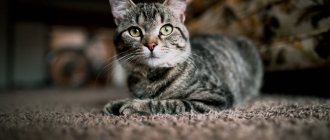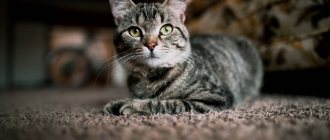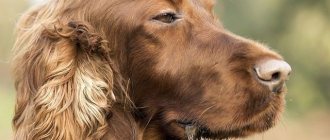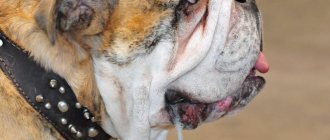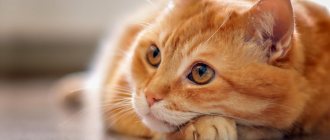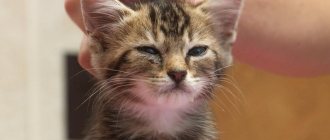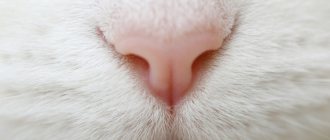In rare cases, the owner of the animal notices that the cat is drooling. If there is excessive drooling, it may be a symptom of illness.
It is important to pay attention to this condition of your pet and track the accompanying symptoms. If there is vomiting, fever, wet fur, or loose stools, it is necessary to examine the animal to find the cause of the illness.
Excessive drooling
Pathology manifests itself with viral infections, problems in the oral cavity, or a foreign object entering the mouth.
Signs
With increased salivation, the following symptoms are observed:
saliva is released abundantly from the animal’s mouth and drips onto the floor;- the cat’s chin, chest, and paws become wet;
- the pet often swallows and rubs its muzzle on the furniture;
- the cat constantly washes itself, rubs its face with its paw;
- the fur sticks together due to the abundance of saliva, icicles appear;
- wet spots remain in the place where the animal sits;
- The tongue does not stay in the mouth, it falls out when the cat sleeps and is awake.
Not all signs of pathology appear immediately. A cat's drooling can vary in intensity.
The cat is drooling, clear as drops of water: what is he talking about?
Regardless of the etiology, ptyalism in the initial stages is characterized by colorless, light discharge. The exception is rabies, which produces foam.
Breeders try to diversify the diet as much as possible so that the furry friend receives all the necessary nutrients, vitamins, and minerals. An unpleasant manifestation can be caused by a bone getting stuck in the gum or palate.
Trauma to the oral mucosa may also be the cause. When a foreign body is stuck or injured, the predator eats only on one side. Tries to remove the irritating bone with his paw.
If your jaw is dislocated, it is difficult for your pet to eat and drink. He makes hysterical sounds and sticks his tongue out to one side. Similar manifestations are observed with stinging insect bites. It is necessary to remove the poisonous sting (if any) and give an antihistamine to prevent swelling of the larynx.
Animals are often taken to the sea. Apartment cats, not accustomed to the scorching sun, receive the gift of heat.
Young kittens are active and playful. The etiological factor of hypersalivation can be a concussion as a result of a blow from a fall from a height.
Sialorrhea: main causes
This is the activation of the function of the salivary glands. The cause of this phenomenon may be nervous disorders, inflammatory processes in the oral cavity, and the use of bitter drugs.
When not to worry
Increased salivation in cats is observed in many cases.
There is no need to worry if the cat has tried a bitter plant, feels nervous, stressed, gets sick in transport, or regurgitates frequently.
Symptoms of drooling pass quickly, there are no other signs of pathology, the animal does not experience discomfort, the drool is clear as water.
Dangerous situations
Increased salivation in a cat is not always a sign of stress or motion sickness. Many diseases are accompanied by this symptom.
The condition is dangerous if:
- a foreign body (fish bone, twig, piece of plastic, etc.) has entered the animal’s mouth or throat;
the cat became infected with a viral infection;- an inflammatory process develops in the oral cavity, there are neoplasms;
- the cat was poisoned;
- the animal overheated and suffered heatstroke;
- there is a suspicion of diseases of the internal organs.
Drooling often occurs with rabies. If saliva is released profusely for a long time, this is a reason to urgently contact a veterinarian.
What should the owner do?
Possible actions on the part of the owner depend on the condition of the animal. If it is healthy, and all the signs of a physiological cause are present, the problem that has arisen will resolve itself.
If you are prone to motion sickness in transport, consult your veterinarian to select tablets. Give them to your cat before every trip.
An object stuck in the teeth should be carefully removed with tweezers. After manipulation, treat the mucous membranes with Miramistin or chlorhexidine to avoid infection. If the foreign body is deeply located, it is better not to take independent actions, since any mistake can lead to injuries to the larynx.
In all other cases, it is recommended to immediately contact a veterinarian. Remember that when infected with certain viruses and helminths, a cat becomes dangerous to humans.
Drooling is a symptom of the disease
Often, excessive salivation is a sign of oral pathologies.
The disease can be recognized by its characteristic symptoms.
Gingivitis
This is an inflammatory disease of the gums that spreads to the mucous membrane near the tooth. If the pathology is not diagnosed and treated for a long time, the gums become deformed and tissues are destroyed, which leads to tooth loss.
Signs: redness of the gums, the appearance of purulent films, restless behavior, refusal of solid food, excessive drooling.
Stomatitis
With stomatitis, the oral mucosa becomes inflamed and ulcers appear. Drooling with this pathology is a typical symptom. The disease is accompanied by severe pain, the cat refuses food and loses weight.
Abscess in the mouth
The disease develops against the background of gingivitis if the tooth enamel is damaged. A cavity filled with pus appears at the root of the tooth.
Salivary gland cyst
Another name for the disease is mucocele.
In the process of eating, small bones or hard pieces of food damage the salivary gland. An excessive accumulation of saliva occurs in its tissues and ducts, which provokes the development of an inflammatory process in the oral cavity.
Acute pharyngitis
Acute pharyngitis can occur independently, and can also be accompanied by acute inflammation affecting the upper respiratory tract: rhinitis or inflammation of the mucous membranes of the nasopharynx.
Depending on the cause of development, acute pharyngitis occurs:
- Viral – most often caused by rhinovirus;
- Bacterial – caused by streptococci, staphylococci and pneumococci;
- Fungal – source of the inflammatory process – Candida;
- Traumatic - caused by damage to the pharynx and larynx: the throat was scratched by a sharp bone or burned by boiling water, severe stress on the ligaments;
- Allergic – occurs when inhaling allergens or irritants, such as tobacco, exhaust fumes or dusty air.
Non-communicable pathologies
During its life, the animal acquires common diseases that are not dangerous to humans and are accompanied by drooling.
Education
The only way to clean a cat's fur is to lick it. Over time, clumps of fluff accumulate in the esophagus, making it difficult for food to move through it. The body tries to get rid of these formations, salivation becomes more active (more often during the molting period).
The pathology is accompanied by other symptoms:
regurgitation;- refusal of food;
- increased thirst;
- constipation;
- bloating.
After defecation, hairballs are found in the animal's feces.
Poisoning
Excessive salivation is caused by toxins.
A cat can eat a poisonous plant, rodent poison in food, a medicine, spoiled food, lick flea treatment or pet shampoo from its fur. Mercury salts also provoke severe salivation.
Allergy
An allergen that enters a cat’s body causes an immune reaction, accompanied by itching, rash, and increased salivation.
Neoplasms in the head and neck area
Lymphomas - malignant neoplasms in the head and neck area in cats do not appear immediately. The first symptom of pathology is drooling.
Metabolic disorders
Such systemic diseases develop due to pathologies of the liver and kidneys. In the acute phase, if the therapeutic diet is violated, drooling may occur.
With an exacerbation of ulcers, colitis, or other problems with the digestive system, excessive salivation, nausea, putrid breath, and regurgitation appear.
Should I be concerned if my cat is drooling?
Increased salivation is an abnormal physiological process that indicates changes in the animal’s body. Ptyalism can be a reaction to a change in food or temperature.
Gradually the pet gets used to it and the glands begin to function normally. You should be concerned if the predator is sick.
Additional symptoms indicate the presence of pathology:
- A runny nose and sneezing are added to the discharge from the mouth. The temperature may rise. The condition is characteristic of viral diseases.
- The appearance of crusts in the corners of the eyes is a sign of infection.
- Anxiety, the cat constantly rubs its face. If an animal constantly touches its mouth with its paw, a small bone may have gotten into the gums.
- Problems with the sense of smell: does not immediately detect the smell of treats. The symptom often accompanies allergies to pollen and medications.
- Decreased appetite, sniffs but does not eat food. The cause of the condition is poisoning.
Behavior also changes, the playful kitten suddenly becomes apathetic. An affectionate animal turns into an aggressive beast.
This behavior is typical of rabies. If any abnormal symptoms occur, the animal is taken to the doctor. Timely treatment will help avoid complications.
Be sure to read:
A cat bite has a swollen hand: what to do, first aid, why it is dangerous, how to treat it, what not to do
Dangerous infections
Diseases in this category are characterized by an acute course.
Excessive salivation is one of the few symptoms accompanying the pathology.
Worm infestations
A large accumulation of parasites in the intestines of an animal leads to poisoning of the body and disruption of the digestive system.
Feline viral leukemia
Causes of occurrence: when the membranes of the digestive and respiratory organs become inflamed, retroviruses suppress the cat’s immune system, which leads to the development of stomatitis, gingivitis, lymphadenitis, resistant to therapy, and neoplasms appear.
This disease is similar to cancer, is a viral form of leukemia, and is often fatal.
Rabies
Dangerous viral disease of animals. The causative agent is the Rabies virus. It affects the cat's nervous system, leading to inflammation of the spinal cord and brain.
The sick animal is isolated from the household. The disease cannot be treated and is fatal.
Associated symptoms:
severe drooling;- inappropriate behavior;
- convulsions;
- rabies;
- voice change;
- paralysis leading to changes in gait.
With rabies, a cat may eat inedible objects; it is irritated by water and its murmuring.
Aujeszky's disease
This is a viral infection that an animal becomes infected with by eating raw pork. With pseudorabies, the nervous system is affected, encephalitis develops, and pathological salivation begins.
Injury
Trauma to the mouth can cause excessive drooling. Oral injuries can occur if a cat bites through an electrical cord and suffers a burn to the mouth. If your cat has recently gotten into a fight with another cat, any trauma to the mouth, such as a broken jaw, may cause drooling.
Keeping a cat indoors reduces the chance of injury from being hit by a car or attacked by a rival cat for territory. An injury to a dislocated temporomandibular joint or a fractured jaw can lead to excessive drooling due to the cat's inability to close its mouth.
If you suspect your cat is drooling due to an oral injury, a thorough oral examination and x-rays may be required to make an accurate medical diagnosis.
Veterinarian help
If there is sudden drooling, profuse discharge, or other signs are observed, then the animal needs urgent medical attention.
Alarming symptoms of drooling:
- inappropriate behavior of a pet;
- no reason for stress;
- changes in the volume of saliva produced during the day;
- drooling for more than 1.5 hours;
- the situation is getting worse.
The animal's oral cavity is first examined to rule out non-viral diseases.
Saliva secretion norms
Saliva should not flow from the cat's mouth. But the appearance of drops on the muzzle is often associated with feeding habits. The need for active fluid production arises when feeding dry food to soak the granules. Eating wet food requires a small amount of saliva, although eating raw meat is accompanied by active gland activity.
Washing after eating
Normal salivation is called salivation, increased salivation is called hypersalivation. Increased drooling is sometimes a harmless manifestation, but together with additional symptoms of disorders, it reflects the development of pathology. Only a veterinarian can help you find out why your cat is actively drooling.
Treatment
In the absence of serious pathologies, the animal can be helped at home . The stuck object is removed from the mouth, and after eating a bitter plant or taking medicine, the animal is given plenty of water.
Clinical researches
Upon admission to the animal clinic, the veterinarian conducts an initial examination of the cat. Then a series of examinations are prescribed to determine the cause of the pathology. Diagnostic methods:
X-ray of the head (allows us to identify pathologies in the roots of teeth);- biopsy of modified mucous membranes and tissues;
- general and biochemical blood test;
- X-ray of the chest and abdominal organs (for internal organs, the procedure is carried out with a contrast liquid to identify foreign bodies and neoplasms);
- analysis of urine and feces to detect inflammatory processes and helminthiasis.
Based on the results of the examination, a diagnosis is made. Treatment is prescribed at home or in a veterinary clinic. The cat is prescribed antibacterial agents, antiviral drugs, vitamins, and a therapeutic diet.
Heatstroke
Flat-faced cats, such as Persians, have a higher risk of heatstroke, which can cause drooling. Although heatstroke is not as common in cats, too much time in the sun or not drinking enough water can have detrimental effects.
Cats love the sun. Always have fresh, clean water on hand. In the summer, make sure your cat has shady places to cool off. Keep your cat indoors on hot days. Never leave a cat in a parked car. Limit training and play time to keep your cat from overheating.
Prevention
The animal is fed special industrial food that does not contain small bones or solid particles.
The kitten must be taught not to resist when examining its mouth and brushing its teeth. The house must be safe for the animal: all household chemicals and medicines are put away in inaccessible places, it is better to avoid poisonous indoor plants.
Other preventive measures:
- apply medicinal ointments and flea preparations only to the animal’s withers; to prevent them from being licked, use a special collar-limiter;
- do not feed the animal fish with small bones, do not give hard objects with small sharp parts as toys;
carry out annual vaccination to protect against viral infections, especially rabies;- treat your pet for helminths at least 2 times a year;
- during the molting period, comb long-haired cats daily;
- do not skip annual preventive examinations at the veterinary clinic (to identify pathologies in the early stages).
The owner should constantly monitor the health of the pet in order to promptly detect the development of the disease and provide the necessary assistance.
Sore throat and pharyngitis: what is the difference?
The general condition of the patient with acute tonsillitis or tonsillitis can be confused with the symptoms of pharyngitis. If the disease is diagnosed incorrectly, then treatment of pharyngitis in adults will not have any effect. And the acute form of the pathology can develop into a chronic one.
Unfortunately, many patients self-medicate and start using medications without a doctor’s specific prescription. This is extremely contraindicated! It is better to take care of your health in time and seek help from an experienced otolaryngologist.
It is important to remember that during pharyngitis, the larynx becomes inflamed, and during tonsillitis, the tonsils become inflamed. During a sore throat, it is always painful to swallow, and the pain intensifies even more when eating food. With pharyngitis, the opposite happens - while eating warm food or warm drinks, the sore throat decreases.
During the development of a sore throat, there is no cough or sore throat, only a sore throat and sometimes the formation of a white coating. With pharyngitis, there is a sore throat, as well as noise, pain, or congestion in the ears. The difficulty in distinguishing between these two diseases is further complicated by the fact that one patient can simultaneously develop both pathologies, since they are caused by the same pathogen.
Diagnostic methods
A complete diagnosis in a veterinary clinic helps to establish the causes of the disease. It helps to determine a possible pathology:
- history taking, examination;
- general, clinical analysis of blood, feces, urine;
- performing ultrasound, radiography, MRI.
Modern research methods make it possible to determine the condition of internal organs, study the functioning of the digestive system, determine the presence of helminthic infestation, trichobezoars, and possible injuries. The animal should be prepared for a number of procedures. For example, to conduct an ultrasound of the gastrointestinal tract, you should not feed for 10 hours.
Pathological factors
A cat's drooling can be caused by diseases - contagious and non-contagious. Hypersalivation accompanies damage to the nervous system in some serious pathologies. The following are contagious:
- Rabies. This is a dangerous disease that can be transmitted to humans and other animals. Symptoms of the pathology: aggressiveness, inadequacy, fear of water and light. Foamy viscous saliva is released from the mouth. With other diseases, the cat's drool is clear. The prognosis for rabies is poor.
- Viral leukemia is an infectious disease that affects the immune and hematopoietic system. Symptoms include stomatitis, gingivitis, loss of teeth; with leukemia, the lymph nodes become enlarged and the cat drools. If the process is advanced, the pet may develop tumors and develop severe anemia. In this case, it is impossible to cure the disease, and therapy is aimed at alleviating the cat’s condition and prolonging its life. The doctor prescribes antibiotics and anticancer drugs.
- Tetanus is a disease that manifests itself in tension and impaired muscle mobility, difficulty moving, spasms, and convulsions. The cat cannot eat because it has difficulty during this process, cannot open its mouth, and drools.
- Respiratory tract infections. Various diseases may cause symptoms such as drooling, sneezing, fever, discharge from the eyes and nose, and mouth ulcers.
Preventive measures
- Compliance with schedules of preventive vaccinations and antiparasitic treatments.
- Maintain hygiene: regular brushing of teeth, examination of the oral cavity.
- Keep household chemicals out of reach of the cat. When using acids, aerosols, varnishes and paints, isolate the animal from their effects.
- Protect your cat from stressful situations.
- Provide your pet with a balanced diet.
- Provide the animal with free access to clean and fresh water.
- Do not grow plants that are poisonous to cats in the house.

